Report on Communication, Negotiation in Professional Management
VerifiedAdded on 2023/06/17
|16
|5329
|336
Report
AI Summary
This report provides an overview of professional skills essential for management, focusing on communication and negotiation. It defines communication, explores verbal and non-verbal types, and discusses their application in the workplace. The report identifies different communicator types, emph...
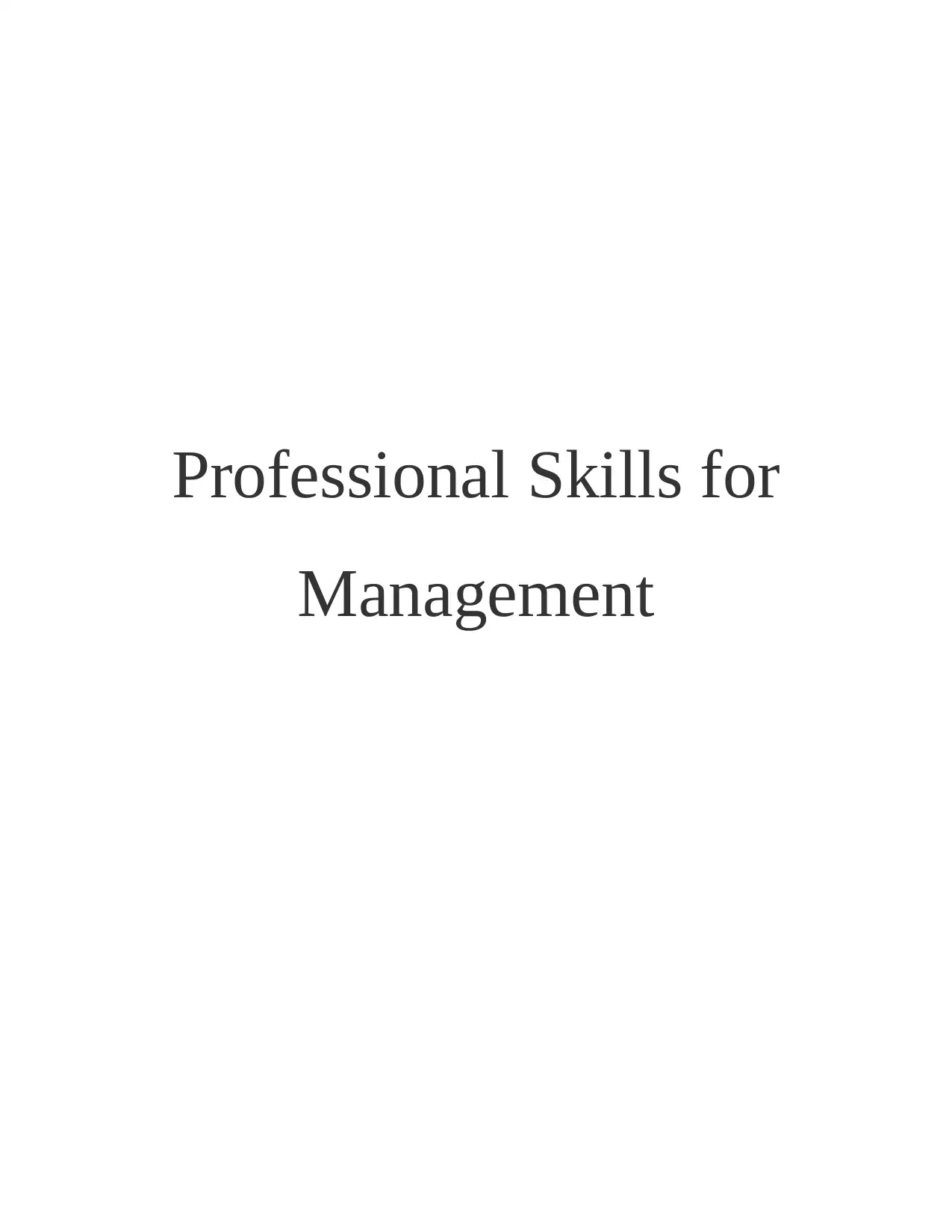
Professional Skills for
Management
Management
Paraphrase This Document
Need a fresh take? Get an instant paraphrase of this document with our AI Paraphraser
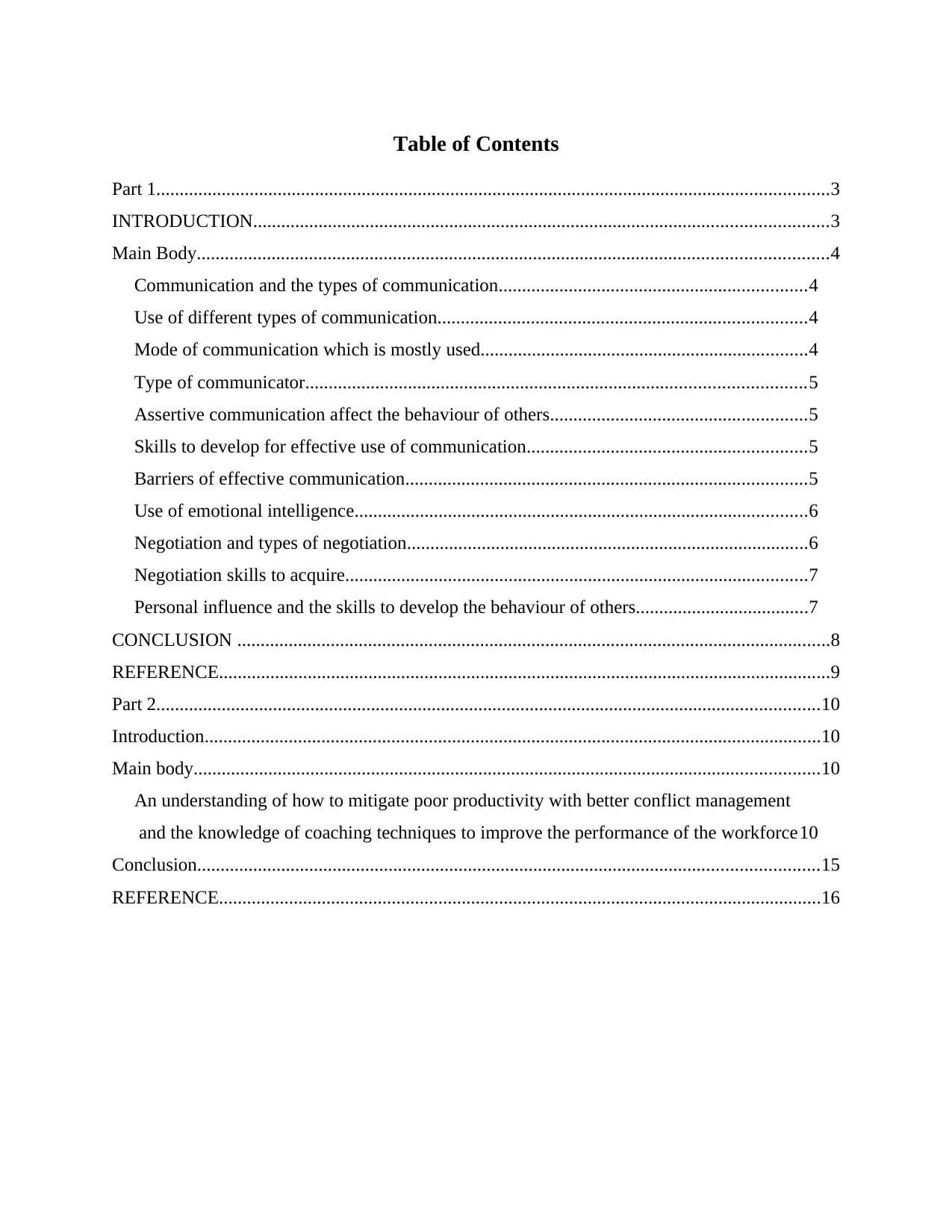
Table of Contents
Part 1................................................................................................................................................3
INTRODUCTION...........................................................................................................................3
Main Body.......................................................................................................................................4
Communication and the types of communication..................................................................4
Use of different types of communication...............................................................................4
Mode of communication which is mostly used......................................................................4
Type of communicator...........................................................................................................5
Assertive communication affect the behaviour of others.......................................................5
Skills to develop for effective use of communication............................................................5
Barriers of effective communication......................................................................................5
Use of emotional intelligence.................................................................................................6
Negotiation and types of negotiation......................................................................................6
Negotiation skills to acquire...................................................................................................7
Personal influence and the skills to develop the behaviour of others.....................................7
CONCLUSION ...............................................................................................................................8
REFERENCE...................................................................................................................................9
Part 2..............................................................................................................................................10
Introduction....................................................................................................................................10
Main body......................................................................................................................................10
An understanding of how to mitigate poor productivity with better conflict management
and the knowledge of coaching techniques to improve the performance of the workforce10
Conclusion.....................................................................................................................................15
REFERENCE.................................................................................................................................16
Part 1................................................................................................................................................3
INTRODUCTION...........................................................................................................................3
Main Body.......................................................................................................................................4
Communication and the types of communication..................................................................4
Use of different types of communication...............................................................................4
Mode of communication which is mostly used......................................................................4
Type of communicator...........................................................................................................5
Assertive communication affect the behaviour of others.......................................................5
Skills to develop for effective use of communication............................................................5
Barriers of effective communication......................................................................................5
Use of emotional intelligence.................................................................................................6
Negotiation and types of negotiation......................................................................................6
Negotiation skills to acquire...................................................................................................7
Personal influence and the skills to develop the behaviour of others.....................................7
CONCLUSION ...............................................................................................................................8
REFERENCE...................................................................................................................................9
Part 2..............................................................................................................................................10
Introduction....................................................................................................................................10
Main body......................................................................................................................................10
An understanding of how to mitigate poor productivity with better conflict management
and the knowledge of coaching techniques to improve the performance of the workforce10
Conclusion.....................................................................................................................................15
REFERENCE.................................................................................................................................16
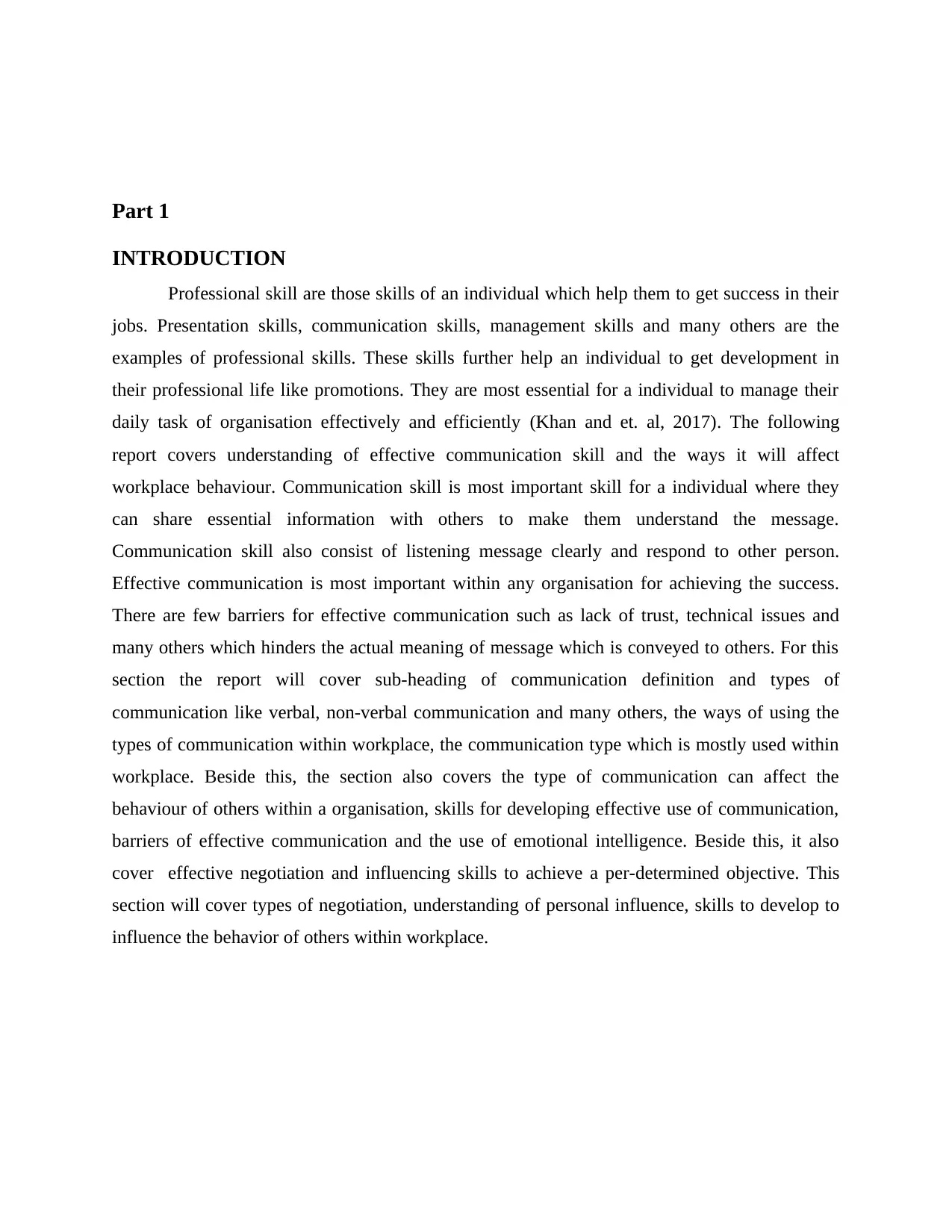
Part 1
INTRODUCTION
Professional skill are those skills of an individual which help them to get success in their
jobs. Presentation skills, communication skills, management skills and many others are the
examples of professional skills. These skills further help an individual to get development in
their professional life like promotions. They are most essential for a individual to manage their
daily task of organisation effectively and efficiently (Khan and et. al, 2017). The following
report covers understanding of effective communication skill and the ways it will affect
workplace behaviour. Communication skill is most important skill for a individual where they
can share essential information with others to make them understand the message.
Communication skill also consist of listening message clearly and respond to other person.
Effective communication is most important within any organisation for achieving the success.
There are few barriers for effective communication such as lack of trust, technical issues and
many others which hinders the actual meaning of message which is conveyed to others. For this
section the report will cover sub-heading of communication definition and types of
communication like verbal, non-verbal communication and many others, the ways of using the
types of communication within workplace, the communication type which is mostly used within
workplace. Beside this, the section also covers the type of communication can affect the
behaviour of others within a organisation, skills for developing effective use of communication,
barriers of effective communication and the use of emotional intelligence. Beside this, it also
cover effective negotiation and influencing skills to achieve a per-determined objective. This
section will cover types of negotiation, understanding of personal influence, skills to develop to
influence the behavior of others within workplace.
INTRODUCTION
Professional skill are those skills of an individual which help them to get success in their
jobs. Presentation skills, communication skills, management skills and many others are the
examples of professional skills. These skills further help an individual to get development in
their professional life like promotions. They are most essential for a individual to manage their
daily task of organisation effectively and efficiently (Khan and et. al, 2017). The following
report covers understanding of effective communication skill and the ways it will affect
workplace behaviour. Communication skill is most important skill for a individual where they
can share essential information with others to make them understand the message.
Communication skill also consist of listening message clearly and respond to other person.
Effective communication is most important within any organisation for achieving the success.
There are few barriers for effective communication such as lack of trust, technical issues and
many others which hinders the actual meaning of message which is conveyed to others. For this
section the report will cover sub-heading of communication definition and types of
communication like verbal, non-verbal communication and many others, the ways of using the
types of communication within workplace, the communication type which is mostly used within
workplace. Beside this, the section also covers the type of communication can affect the
behaviour of others within a organisation, skills for developing effective use of communication,
barriers of effective communication and the use of emotional intelligence. Beside this, it also
cover effective negotiation and influencing skills to achieve a per-determined objective. This
section will cover types of negotiation, understanding of personal influence, skills to develop to
influence the behavior of others within workplace.
⊘ This is a preview!⊘
Do you want full access?
Subscribe today to unlock all pages.

Trusted by 1+ million students worldwide

Main Body
Communication and the types of communication
Communication is the skill of an individual which is used to convey messages to others
in a effective way so that receiver will receive the actual meaning of message which the deliver
want to convey. There are various types of communication and few of them are explained below-
Verbal communication- Here, individuals share their message through spoken words or
sign language. A official meeting of face-to-face communication is a good example of verbal
communication (Kaplonyi and et. al., 2017).
Non- verbal communication- This type of communication uses body language, tone of
voice and facial expressions to share any information. For example, in a hotel when waiters show
thumbs up sign then other staff member understand the message that everything is perfectly
managed.
Use of different types of communication
Different types of communication is used within a organization. In week 3, I have learned
about two types of communication and underrated their effective implementation. In class when
we discuss about any case study or class discussion then it will be conducted by face- to face
communication which is a verbal communication. In context of class activity, when a student
who is standing far away from me and convey any message then I provide feedback by rotating
my neck horizontally to say no and move it vertically to convey yes. This is the type of non-
verbal communication which is supposed to use when I need to convey short message to the
student who is sitting in a distance with me.
Mode of communication which is mostly used
According to me, verbal communication is used majorly in my class activities because
most of the students and teachers interact face-to face and share information so no doubt or
misunderstanding will create among them (Bullington and et. al., 2019). For example in class
discussion or group discussion we all interact with each other and share our point of view on
topic given by teacher and in case any student convey some wrong information then our teacher
make it correct on the spot to correct our knowledge. After finishing any task, our teacher also
provide feedback about how students represent class activities and what all are their strengths
and weaknesses so that they can work upon their weakness.
Communication and the types of communication
Communication is the skill of an individual which is used to convey messages to others
in a effective way so that receiver will receive the actual meaning of message which the deliver
want to convey. There are various types of communication and few of them are explained below-
Verbal communication- Here, individuals share their message through spoken words or
sign language. A official meeting of face-to-face communication is a good example of verbal
communication (Kaplonyi and et. al., 2017).
Non- verbal communication- This type of communication uses body language, tone of
voice and facial expressions to share any information. For example, in a hotel when waiters show
thumbs up sign then other staff member understand the message that everything is perfectly
managed.
Use of different types of communication
Different types of communication is used within a organization. In week 3, I have learned
about two types of communication and underrated their effective implementation. In class when
we discuss about any case study or class discussion then it will be conducted by face- to face
communication which is a verbal communication. In context of class activity, when a student
who is standing far away from me and convey any message then I provide feedback by rotating
my neck horizontally to say no and move it vertically to convey yes. This is the type of non-
verbal communication which is supposed to use when I need to convey short message to the
student who is sitting in a distance with me.
Mode of communication which is mostly used
According to me, verbal communication is used majorly in my class activities because
most of the students and teachers interact face-to face and share information so no doubt or
misunderstanding will create among them (Bullington and et. al., 2019). For example in class
discussion or group discussion we all interact with each other and share our point of view on
topic given by teacher and in case any student convey some wrong information then our teacher
make it correct on the spot to correct our knowledge. After finishing any task, our teacher also
provide feedback about how students represent class activities and what all are their strengths
and weaknesses so that they can work upon their weakness.
Paraphrase This Document
Need a fresh take? Get an instant paraphrase of this document with our AI Paraphraser
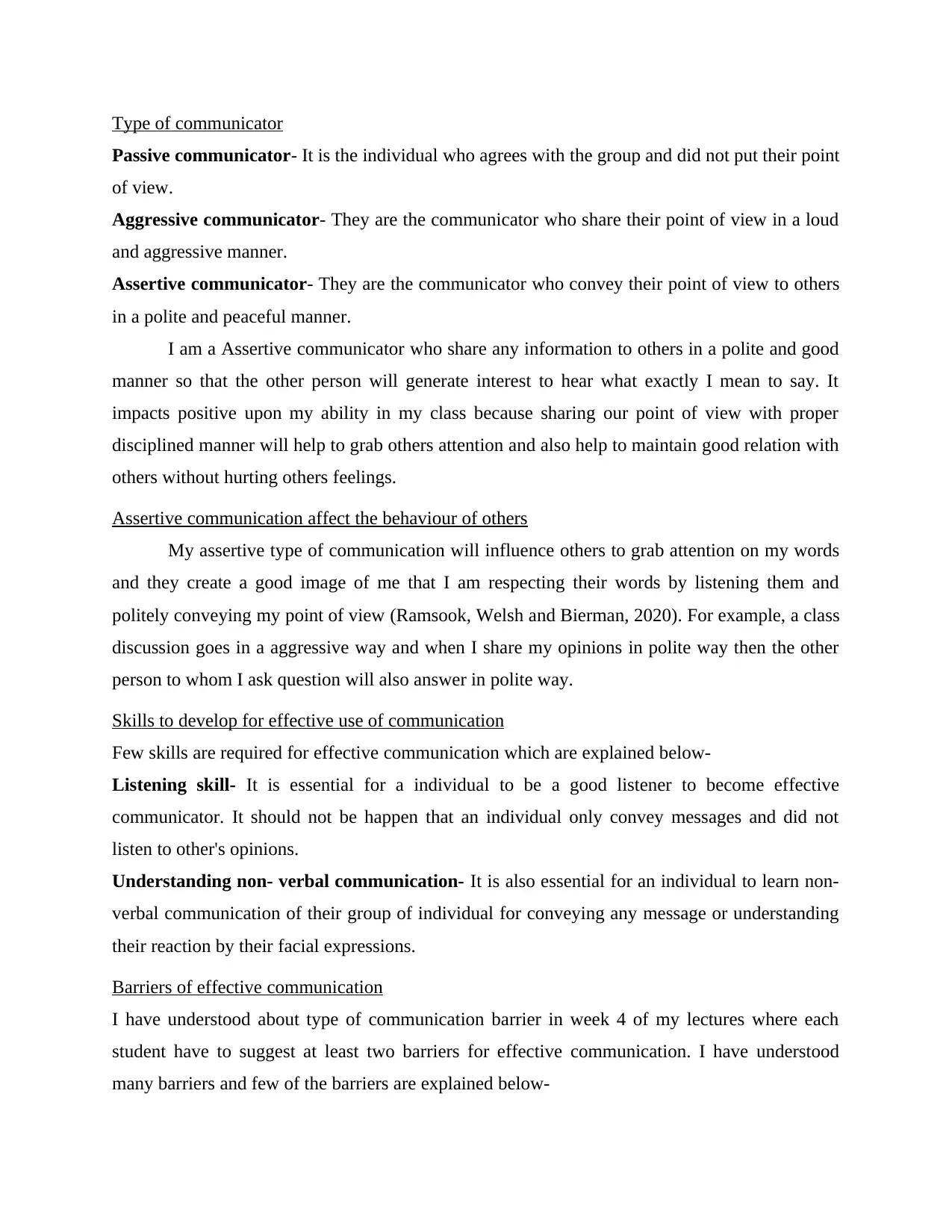
Type of communicator
Passive communicator- It is the individual who agrees with the group and did not put their point
of view.
Aggressive communicator- They are the communicator who share their point of view in a loud
and aggressive manner.
Assertive communicator- They are the communicator who convey their point of view to others
in a polite and peaceful manner.
I am a Assertive communicator who share any information to others in a polite and good
manner so that the other person will generate interest to hear what exactly I mean to say. It
impacts positive upon my ability in my class because sharing our point of view with proper
disciplined manner will help to grab others attention and also help to maintain good relation with
others without hurting others feelings.
Assertive communication affect the behaviour of others
My assertive type of communication will influence others to grab attention on my words
and they create a good image of me that I am respecting their words by listening them and
politely conveying my point of view (Ramsook, Welsh and Bierman, 2020). For example, a class
discussion goes in a aggressive way and when I share my opinions in polite way then the other
person to whom I ask question will also answer in polite way.
Skills to develop for effective use of communication
Few skills are required for effective communication which are explained below-
Listening skill- It is essential for a individual to be a good listener to become effective
communicator. It should not be happen that an individual only convey messages and did not
listen to other's opinions.
Understanding non- verbal communication- It is also essential for an individual to learn non-
verbal communication of their group of individual for conveying any message or understanding
their reaction by their facial expressions.
Barriers of effective communication
I have understood about type of communication barrier in week 4 of my lectures where each
student have to suggest at least two barriers for effective communication. I have understood
many barriers and few of the barriers are explained below-
Passive communicator- It is the individual who agrees with the group and did not put their point
of view.
Aggressive communicator- They are the communicator who share their point of view in a loud
and aggressive manner.
Assertive communicator- They are the communicator who convey their point of view to others
in a polite and peaceful manner.
I am a Assertive communicator who share any information to others in a polite and good
manner so that the other person will generate interest to hear what exactly I mean to say. It
impacts positive upon my ability in my class because sharing our point of view with proper
disciplined manner will help to grab others attention and also help to maintain good relation with
others without hurting others feelings.
Assertive communication affect the behaviour of others
My assertive type of communication will influence others to grab attention on my words
and they create a good image of me that I am respecting their words by listening them and
politely conveying my point of view (Ramsook, Welsh and Bierman, 2020). For example, a class
discussion goes in a aggressive way and when I share my opinions in polite way then the other
person to whom I ask question will also answer in polite way.
Skills to develop for effective use of communication
Few skills are required for effective communication which are explained below-
Listening skill- It is essential for a individual to be a good listener to become effective
communicator. It should not be happen that an individual only convey messages and did not
listen to other's opinions.
Understanding non- verbal communication- It is also essential for an individual to learn non-
verbal communication of their group of individual for conveying any message or understanding
their reaction by their facial expressions.
Barriers of effective communication
I have understood about type of communication barrier in week 4 of my lectures where each
student have to suggest at least two barriers for effective communication. I have understood
many barriers and few of the barriers are explained below-
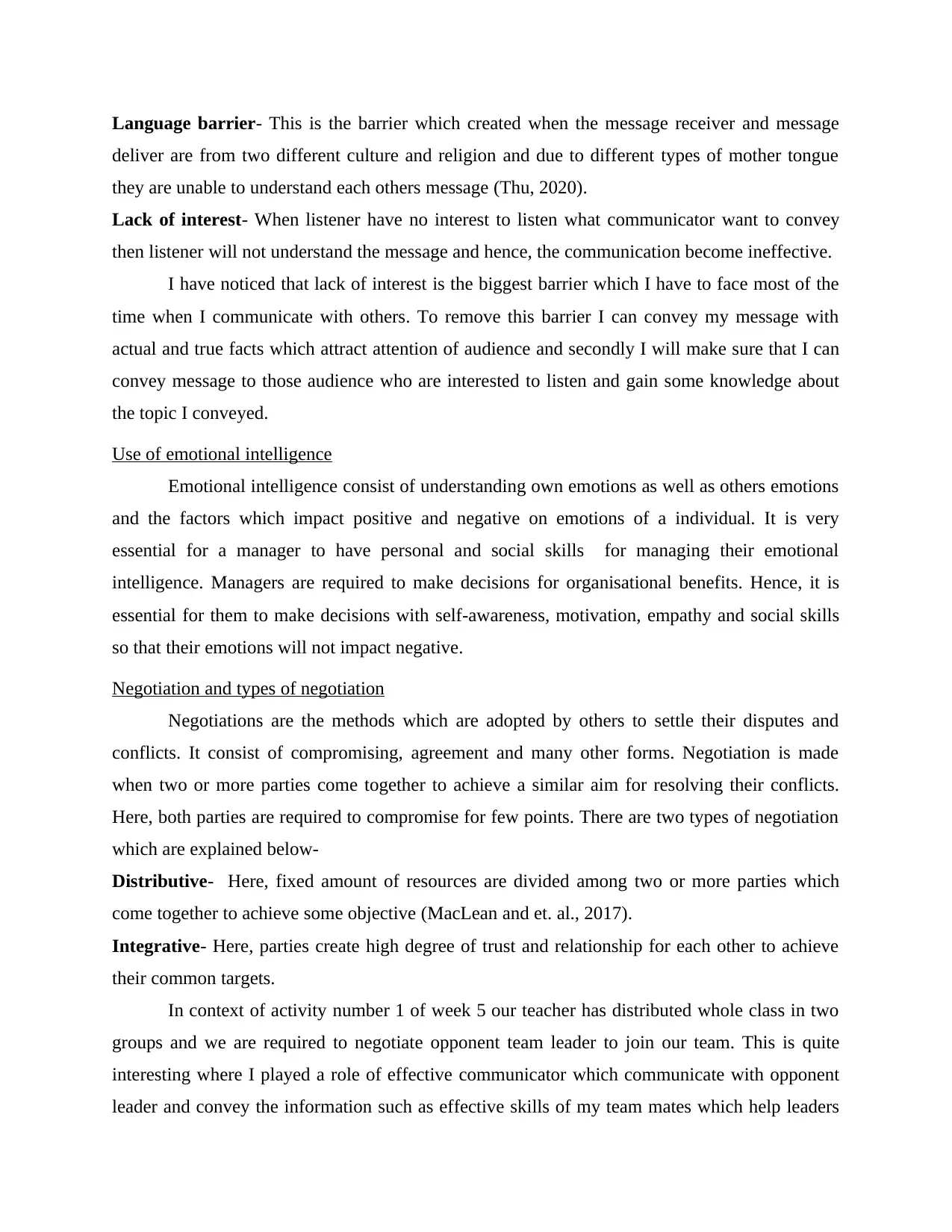
Language barrier- This is the barrier which created when the message receiver and message
deliver are from two different culture and religion and due to different types of mother tongue
they are unable to understand each others message (Thu, 2020).
Lack of interest- When listener have no interest to listen what communicator want to convey
then listener will not understand the message and hence, the communication become ineffective.
I have noticed that lack of interest is the biggest barrier which I have to face most of the
time when I communicate with others. To remove this barrier I can convey my message with
actual and true facts which attract attention of audience and secondly I will make sure that I can
convey message to those audience who are interested to listen and gain some knowledge about
the topic I conveyed.
Use of emotional intelligence
Emotional intelligence consist of understanding own emotions as well as others emotions
and the factors which impact positive and negative on emotions of a individual. It is very
essential for a manager to have personal and social skills for managing their emotional
intelligence. Managers are required to make decisions for organisational benefits. Hence, it is
essential for them to make decisions with self-awareness, motivation, empathy and social skills
so that their emotions will not impact negative.
Negotiation and types of negotiation
Negotiations are the methods which are adopted by others to settle their disputes and
conflicts. It consist of compromising, agreement and many other forms. Negotiation is made
when two or more parties come together to achieve a similar aim for resolving their conflicts.
Here, both parties are required to compromise for few points. There are two types of negotiation
which are explained below-
Distributive- Here, fixed amount of resources are divided among two or more parties which
come together to achieve some objective (MacLean and et. al., 2017).
Integrative- Here, parties create high degree of trust and relationship for each other to achieve
their common targets.
In context of activity number 1 of week 5 our teacher has distributed whole class in two
groups and we are required to negotiate opponent team leader to join our team. This is quite
interesting where I played a role of effective communicator which communicate with opponent
leader and convey the information such as effective skills of my team mates which help leaders
deliver are from two different culture and religion and due to different types of mother tongue
they are unable to understand each others message (Thu, 2020).
Lack of interest- When listener have no interest to listen what communicator want to convey
then listener will not understand the message and hence, the communication become ineffective.
I have noticed that lack of interest is the biggest barrier which I have to face most of the
time when I communicate with others. To remove this barrier I can convey my message with
actual and true facts which attract attention of audience and secondly I will make sure that I can
convey message to those audience who are interested to listen and gain some knowledge about
the topic I conveyed.
Use of emotional intelligence
Emotional intelligence consist of understanding own emotions as well as others emotions
and the factors which impact positive and negative on emotions of a individual. It is very
essential for a manager to have personal and social skills for managing their emotional
intelligence. Managers are required to make decisions for organisational benefits. Hence, it is
essential for them to make decisions with self-awareness, motivation, empathy and social skills
so that their emotions will not impact negative.
Negotiation and types of negotiation
Negotiations are the methods which are adopted by others to settle their disputes and
conflicts. It consist of compromising, agreement and many other forms. Negotiation is made
when two or more parties come together to achieve a similar aim for resolving their conflicts.
Here, both parties are required to compromise for few points. There are two types of negotiation
which are explained below-
Distributive- Here, fixed amount of resources are divided among two or more parties which
come together to achieve some objective (MacLean and et. al., 2017).
Integrative- Here, parties create high degree of trust and relationship for each other to achieve
their common targets.
In context of activity number 1 of week 5 our teacher has distributed whole class in two
groups and we are required to negotiate opponent team leader to join our team. This is quite
interesting where I played a role of effective communicator which communicate with opponent
leader and convey the information such as effective skills of my team mates which help leaders
⊘ This is a preview!⊘
Do you want full access?
Subscribe today to unlock all pages.

Trusted by 1+ million students worldwide
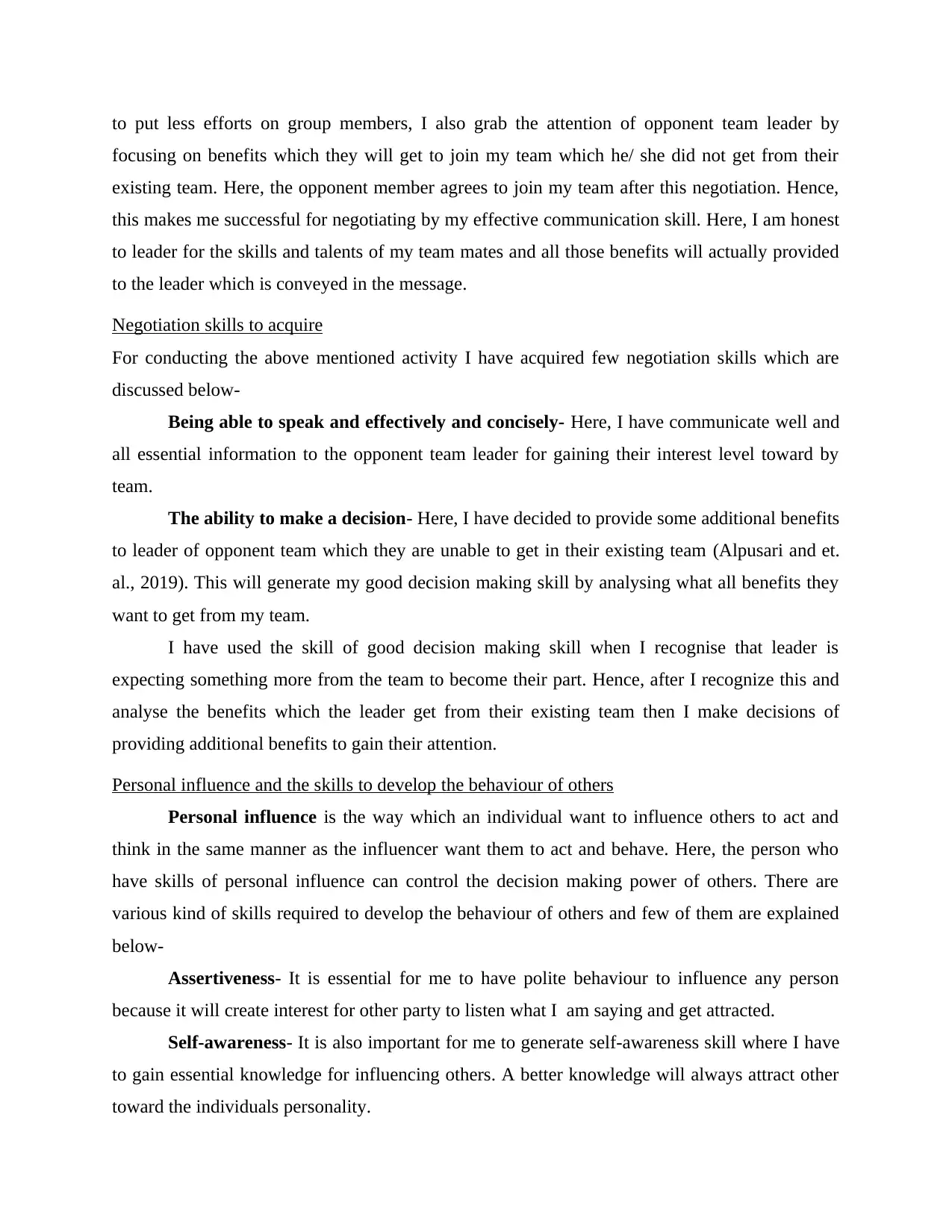
to put less efforts on group members, I also grab the attention of opponent team leader by
focusing on benefits which they will get to join my team which he/ she did not get from their
existing team. Here, the opponent member agrees to join my team after this negotiation. Hence,
this makes me successful for negotiating by my effective communication skill. Here, I am honest
to leader for the skills and talents of my team mates and all those benefits will actually provided
to the leader which is conveyed in the message.
Negotiation skills to acquire
For conducting the above mentioned activity I have acquired few negotiation skills which are
discussed below-
Being able to speak and effectively and concisely- Here, I have communicate well and
all essential information to the opponent team leader for gaining their interest level toward by
team.
The ability to make a decision- Here, I have decided to provide some additional benefits
to leader of opponent team which they are unable to get in their existing team (Alpusari and et.
al., 2019). This will generate my good decision making skill by analysing what all benefits they
want to get from my team.
I have used the skill of good decision making skill when I recognise that leader is
expecting something more from the team to become their part. Hence, after I recognize this and
analyse the benefits which the leader get from their existing team then I make decisions of
providing additional benefits to gain their attention.
Personal influence and the skills to develop the behaviour of others
Personal influence is the way which an individual want to influence others to act and
think in the same manner as the influencer want them to act and behave. Here, the person who
have skills of personal influence can control the decision making power of others. There are
various kind of skills required to develop the behaviour of others and few of them are explained
below-
Assertiveness- It is essential for me to have polite behaviour to influence any person
because it will create interest for other party to listen what I am saying and get attracted.
Self-awareness- It is also important for me to generate self-awareness skill where I have
to gain essential knowledge for influencing others. A better knowledge will always attract other
toward the individuals personality.
focusing on benefits which they will get to join my team which he/ she did not get from their
existing team. Here, the opponent member agrees to join my team after this negotiation. Hence,
this makes me successful for negotiating by my effective communication skill. Here, I am honest
to leader for the skills and talents of my team mates and all those benefits will actually provided
to the leader which is conveyed in the message.
Negotiation skills to acquire
For conducting the above mentioned activity I have acquired few negotiation skills which are
discussed below-
Being able to speak and effectively and concisely- Here, I have communicate well and
all essential information to the opponent team leader for gaining their interest level toward by
team.
The ability to make a decision- Here, I have decided to provide some additional benefits
to leader of opponent team which they are unable to get in their existing team (Alpusari and et.
al., 2019). This will generate my good decision making skill by analysing what all benefits they
want to get from my team.
I have used the skill of good decision making skill when I recognise that leader is
expecting something more from the team to become their part. Hence, after I recognize this and
analyse the benefits which the leader get from their existing team then I make decisions of
providing additional benefits to gain their attention.
Personal influence and the skills to develop the behaviour of others
Personal influence is the way which an individual want to influence others to act and
think in the same manner as the influencer want them to act and behave. Here, the person who
have skills of personal influence can control the decision making power of others. There are
various kind of skills required to develop the behaviour of others and few of them are explained
below-
Assertiveness- It is essential for me to have polite behaviour to influence any person
because it will create interest for other party to listen what I am saying and get attracted.
Self-awareness- It is also important for me to generate self-awareness skill where I have
to gain essential knowledge for influencing others. A better knowledge will always attract other
toward the individuals personality.
Paraphrase This Document
Need a fresh take? Get an instant paraphrase of this document with our AI Paraphraser
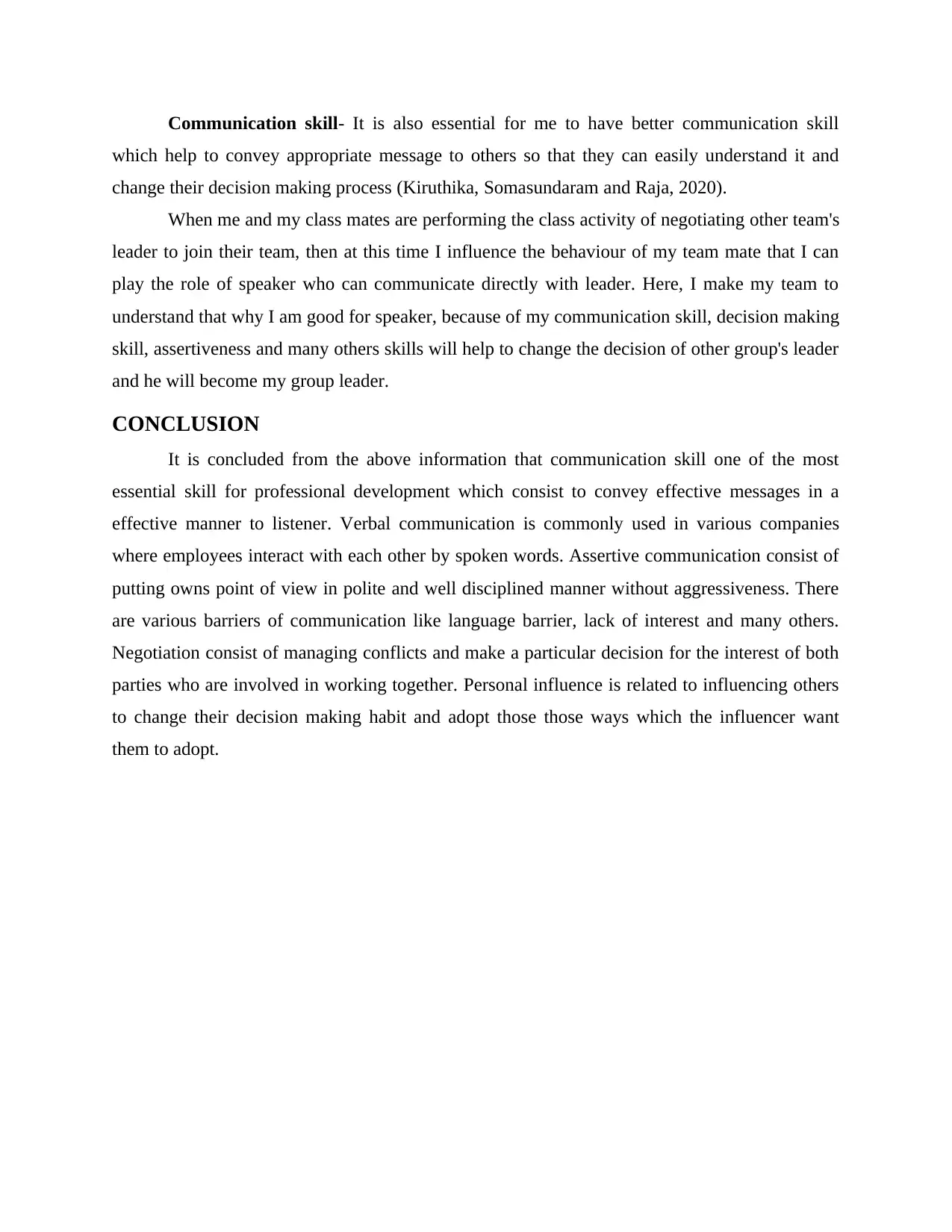
Communication skill- It is also essential for me to have better communication skill
which help to convey appropriate message to others so that they can easily understand it and
change their decision making process (Kiruthika, Somasundaram and Raja, 2020).
When me and my class mates are performing the class activity of negotiating other team's
leader to join their team, then at this time I influence the behaviour of my team mate that I can
play the role of speaker who can communicate directly with leader. Here, I make my team to
understand that why I am good for speaker, because of my communication skill, decision making
skill, assertiveness and many others skills will help to change the decision of other group's leader
and he will become my group leader.
CONCLUSION
It is concluded from the above information that communication skill one of the most
essential skill for professional development which consist to convey effective messages in a
effective manner to listener. Verbal communication is commonly used in various companies
where employees interact with each other by spoken words. Assertive communication consist of
putting owns point of view in polite and well disciplined manner without aggressiveness. There
are various barriers of communication like language barrier, lack of interest and many others.
Negotiation consist of managing conflicts and make a particular decision for the interest of both
parties who are involved in working together. Personal influence is related to influencing others
to change their decision making habit and adopt those those ways which the influencer want
them to adopt.
which help to convey appropriate message to others so that they can easily understand it and
change their decision making process (Kiruthika, Somasundaram and Raja, 2020).
When me and my class mates are performing the class activity of negotiating other team's
leader to join their team, then at this time I influence the behaviour of my team mate that I can
play the role of speaker who can communicate directly with leader. Here, I make my team to
understand that why I am good for speaker, because of my communication skill, decision making
skill, assertiveness and many others skills will help to change the decision of other group's leader
and he will become my group leader.
CONCLUSION
It is concluded from the above information that communication skill one of the most
essential skill for professional development which consist to convey effective messages in a
effective manner to listener. Verbal communication is commonly used in various companies
where employees interact with each other by spoken words. Assertive communication consist of
putting owns point of view in polite and well disciplined manner without aggressiveness. There
are various barriers of communication like language barrier, lack of interest and many others.
Negotiation consist of managing conflicts and make a particular decision for the interest of both
parties who are involved in working together. Personal influence is related to influencing others
to change their decision making habit and adopt those those ways which the influencer want
them to adopt.
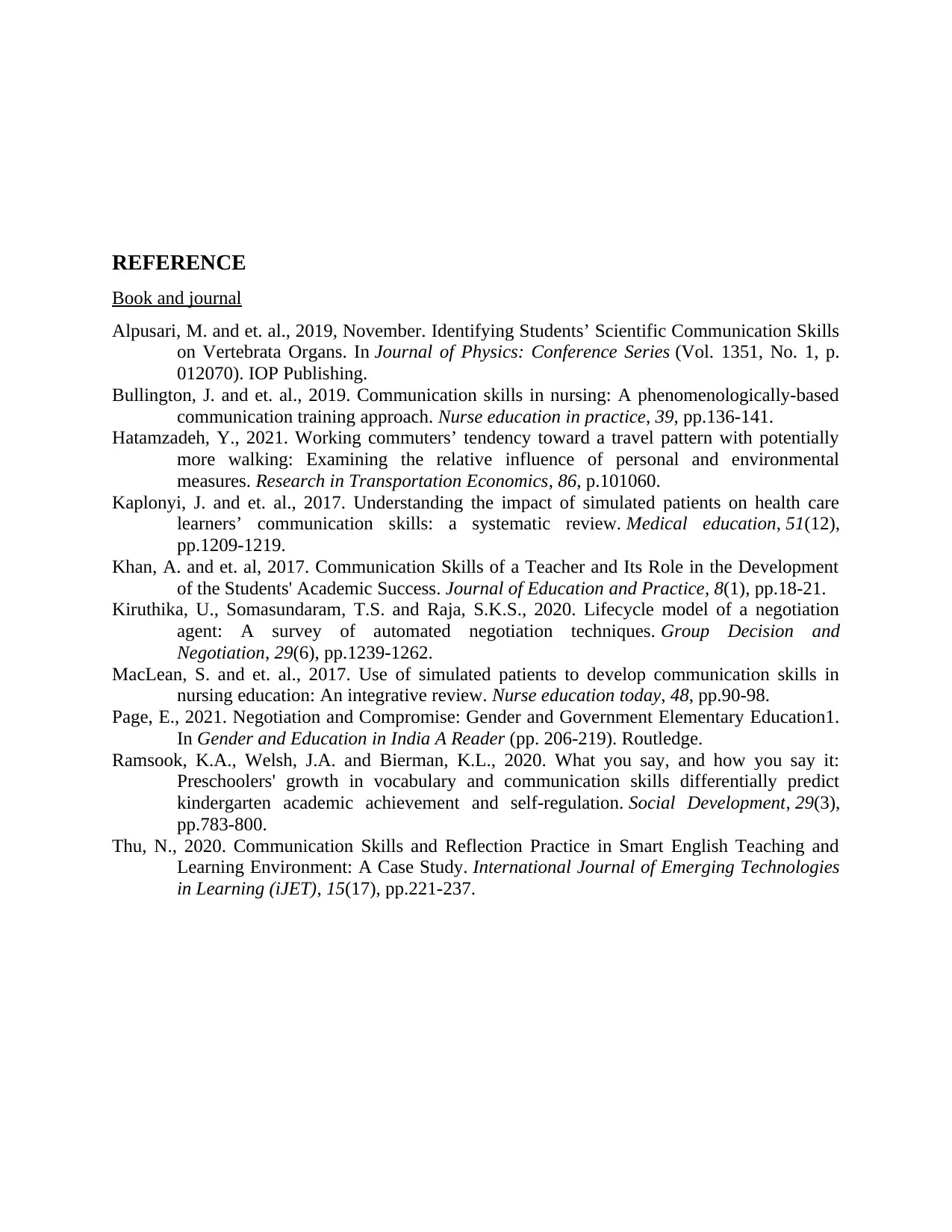
REFERENCE
Book and journal
Alpusari, M. and et. al., 2019, November. Identifying Students’ Scientific Communication Skills
on Vertebrata Organs. In Journal of Physics: Conference Series (Vol. 1351, No. 1, p.
012070). IOP Publishing.
Bullington, J. and et. al., 2019. Communication skills in nursing: A phenomenologically-based
communication training approach. Nurse education in practice, 39, pp.136-141.
Hatamzadeh, Y., 2021. Working commuters’ tendency toward a travel pattern with potentially
more walking: Examining the relative influence of personal and environmental
measures. Research in Transportation Economics, 86, p.101060.
Kaplonyi, J. and et. al., 2017. Understanding the impact of simulated patients on health care
learners’ communication skills: a systematic review. Medical education, 51(12),
pp.1209-1219.
Khan, A. and et. al, 2017. Communication Skills of a Teacher and Its Role in the Development
of the Students' Academic Success. Journal of Education and Practice, 8(1), pp.18-21.
Kiruthika, U., Somasundaram, T.S. and Raja, S.K.S., 2020. Lifecycle model of a negotiation
agent: A survey of automated negotiation techniques. Group Decision and
Negotiation, 29(6), pp.1239-1262.
MacLean, S. and et. al., 2017. Use of simulated patients to develop communication skills in
nursing education: An integrative review. Nurse education today, 48, pp.90-98.
Page, E., 2021. Negotiation and Compromise: Gender and Government Elementary Education1.
In Gender and Education in India A Reader (pp. 206-219). Routledge.
Ramsook, K.A., Welsh, J.A. and Bierman, K.L., 2020. What you say, and how you say it:
Preschoolers' growth in vocabulary and communication skills differentially predict
kindergarten academic achievement and self‐regulation. Social Development, 29(3),
pp.783-800.
Thu, N., 2020. Communication Skills and Reflection Practice in Smart English Teaching and
Learning Environment: A Case Study. International Journal of Emerging Technologies
in Learning (iJET), 15(17), pp.221-237.
Book and journal
Alpusari, M. and et. al., 2019, November. Identifying Students’ Scientific Communication Skills
on Vertebrata Organs. In Journal of Physics: Conference Series (Vol. 1351, No. 1, p.
012070). IOP Publishing.
Bullington, J. and et. al., 2019. Communication skills in nursing: A phenomenologically-based
communication training approach. Nurse education in practice, 39, pp.136-141.
Hatamzadeh, Y., 2021. Working commuters’ tendency toward a travel pattern with potentially
more walking: Examining the relative influence of personal and environmental
measures. Research in Transportation Economics, 86, p.101060.
Kaplonyi, J. and et. al., 2017. Understanding the impact of simulated patients on health care
learners’ communication skills: a systematic review. Medical education, 51(12),
pp.1209-1219.
Khan, A. and et. al, 2017. Communication Skills of a Teacher and Its Role in the Development
of the Students' Academic Success. Journal of Education and Practice, 8(1), pp.18-21.
Kiruthika, U., Somasundaram, T.S. and Raja, S.K.S., 2020. Lifecycle model of a negotiation
agent: A survey of automated negotiation techniques. Group Decision and
Negotiation, 29(6), pp.1239-1262.
MacLean, S. and et. al., 2017. Use of simulated patients to develop communication skills in
nursing education: An integrative review. Nurse education today, 48, pp.90-98.
Page, E., 2021. Negotiation and Compromise: Gender and Government Elementary Education1.
In Gender and Education in India A Reader (pp. 206-219). Routledge.
Ramsook, K.A., Welsh, J.A. and Bierman, K.L., 2020. What you say, and how you say it:
Preschoolers' growth in vocabulary and communication skills differentially predict
kindergarten academic achievement and self‐regulation. Social Development, 29(3),
pp.783-800.
Thu, N., 2020. Communication Skills and Reflection Practice in Smart English Teaching and
Learning Environment: A Case Study. International Journal of Emerging Technologies
in Learning (iJET), 15(17), pp.221-237.
⊘ This is a preview!⊘
Do you want full access?
Subscribe today to unlock all pages.

Trusted by 1+ million students worldwide
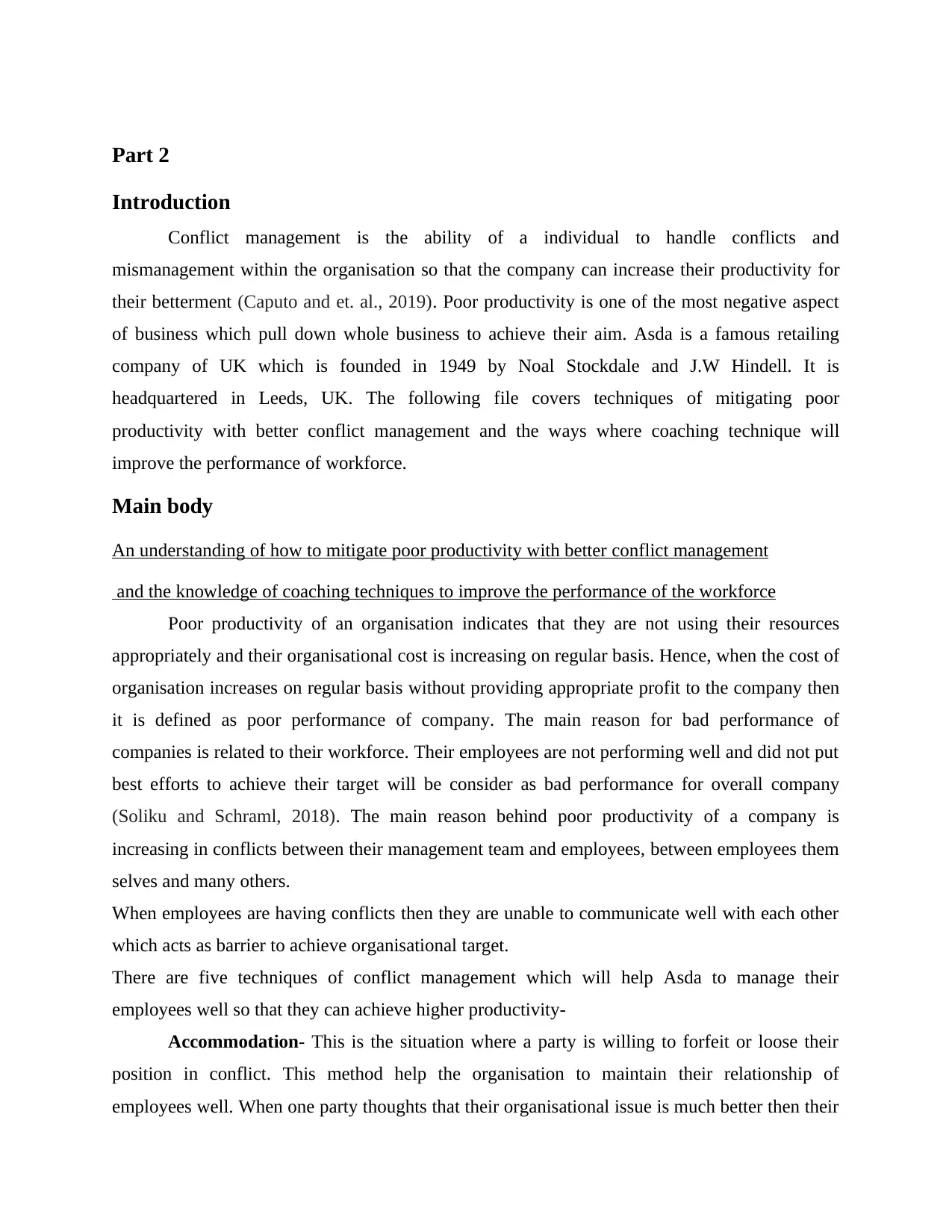
Part 2
Introduction
Conflict management is the ability of a individual to handle conflicts and
mismanagement within the organisation so that the company can increase their productivity for
their betterment (Caputo and et. al., 2019). Poor productivity is one of the most negative aspect
of business which pull down whole business to achieve their aim. Asda is a famous retailing
company of UK which is founded in 1949 by Noal Stockdale and J.W Hindell. It is
headquartered in Leeds, UK. The following file covers techniques of mitigating poor
productivity with better conflict management and the ways where coaching technique will
improve the performance of workforce.
Main body
An understanding of how to mitigate poor productivity with better conflict management
and the knowledge of coaching techniques to improve the performance of the workforce
Poor productivity of an organisation indicates that they are not using their resources
appropriately and their organisational cost is increasing on regular basis. Hence, when the cost of
organisation increases on regular basis without providing appropriate profit to the company then
it is defined as poor performance of company. The main reason for bad performance of
companies is related to their workforce. Their employees are not performing well and did not put
best efforts to achieve their target will be consider as bad performance for overall company
(Soliku and Schraml, 2018). The main reason behind poor productivity of a company is
increasing in conflicts between their management team and employees, between employees them
selves and many others.
When employees are having conflicts then they are unable to communicate well with each other
which acts as barrier to achieve organisational target.
There are five techniques of conflict management which will help Asda to manage their
employees well so that they can achieve higher productivity-
Accommodation- This is the situation where a party is willing to forfeit or loose their
position in conflict. This method help the organisation to maintain their relationship of
employees well. When one party thoughts that their organisational issue is much better then their
Introduction
Conflict management is the ability of a individual to handle conflicts and
mismanagement within the organisation so that the company can increase their productivity for
their betterment (Caputo and et. al., 2019). Poor productivity is one of the most negative aspect
of business which pull down whole business to achieve their aim. Asda is a famous retailing
company of UK which is founded in 1949 by Noal Stockdale and J.W Hindell. It is
headquartered in Leeds, UK. The following file covers techniques of mitigating poor
productivity with better conflict management and the ways where coaching technique will
improve the performance of workforce.
Main body
An understanding of how to mitigate poor productivity with better conflict management
and the knowledge of coaching techniques to improve the performance of the workforce
Poor productivity of an organisation indicates that they are not using their resources
appropriately and their organisational cost is increasing on regular basis. Hence, when the cost of
organisation increases on regular basis without providing appropriate profit to the company then
it is defined as poor performance of company. The main reason for bad performance of
companies is related to their workforce. Their employees are not performing well and did not put
best efforts to achieve their target will be consider as bad performance for overall company
(Soliku and Schraml, 2018). The main reason behind poor productivity of a company is
increasing in conflicts between their management team and employees, between employees them
selves and many others.
When employees are having conflicts then they are unable to communicate well with each other
which acts as barrier to achieve organisational target.
There are five techniques of conflict management which will help Asda to manage their
employees well so that they can achieve higher productivity-
Accommodation- This is the situation where a party is willing to forfeit or loose their
position in conflict. This method help the organisation to maintain their relationship of
employees well. When one party thoughts that their organisational issue is much better then their
Paraphrase This Document
Need a fresh take? Get an instant paraphrase of this document with our AI Paraphraser
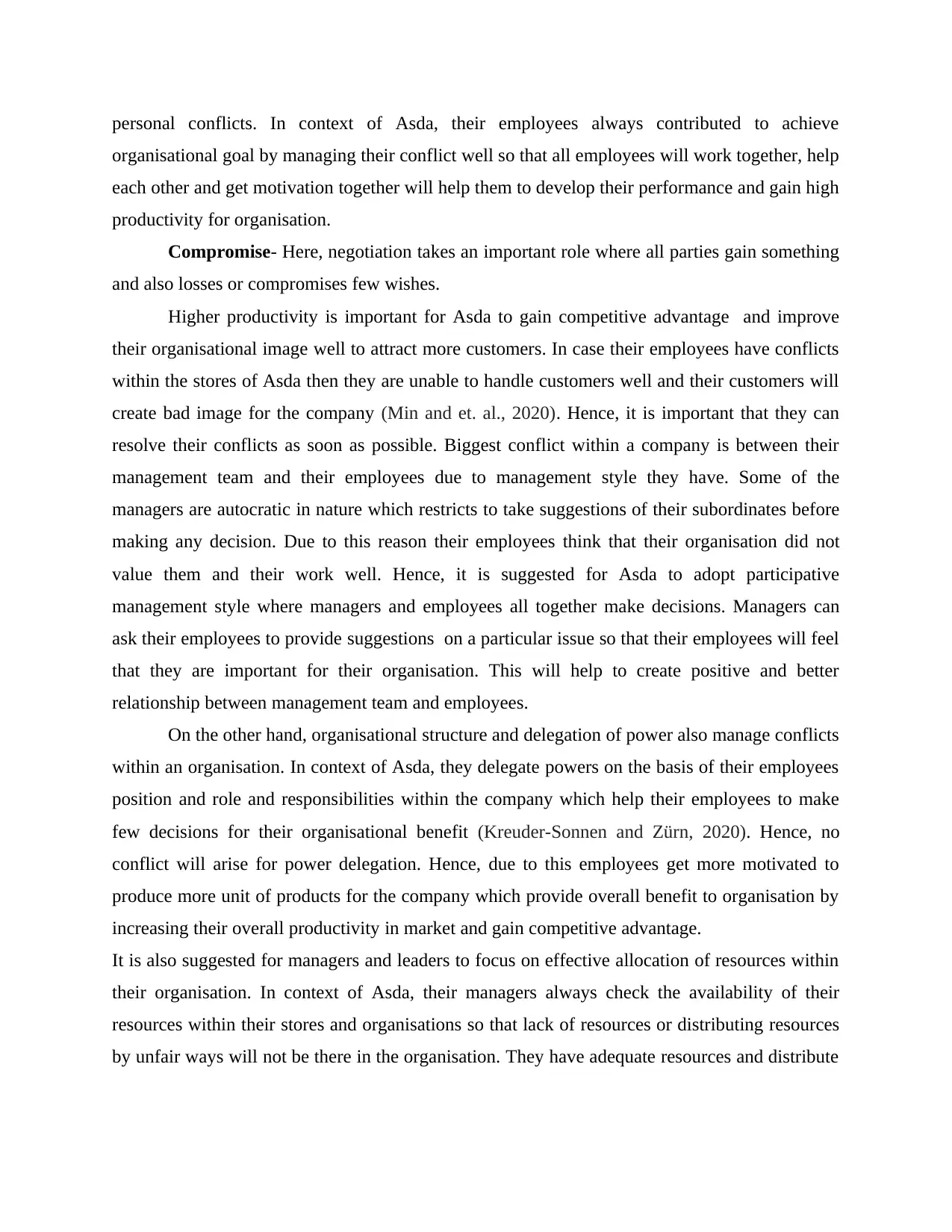
personal conflicts. In context of Asda, their employees always contributed to achieve
organisational goal by managing their conflict well so that all employees will work together, help
each other and get motivation together will help them to develop their performance and gain high
productivity for organisation.
Compromise- Here, negotiation takes an important role where all parties gain something
and also losses or compromises few wishes.
Higher productivity is important for Asda to gain competitive advantage and improve
their organisational image well to attract more customers. In case their employees have conflicts
within the stores of Asda then they are unable to handle customers well and their customers will
create bad image for the company (Min and et. al., 2020). Hence, it is important that they can
resolve their conflicts as soon as possible. Biggest conflict within a company is between their
management team and their employees due to management style they have. Some of the
managers are autocratic in nature which restricts to take suggestions of their subordinates before
making any decision. Due to this reason their employees think that their organisation did not
value them and their work well. Hence, it is suggested for Asda to adopt participative
management style where managers and employees all together make decisions. Managers can
ask their employees to provide suggestions on a particular issue so that their employees will feel
that they are important for their organisation. This will help to create positive and better
relationship between management team and employees.
On the other hand, organisational structure and delegation of power also manage conflicts
within an organisation. In context of Asda, they delegate powers on the basis of their employees
position and role and responsibilities within the company which help their employees to make
few decisions for their organisational benefit (Kreuder-Sonnen and Zürn, 2020). Hence, no
conflict will arise for power delegation. Hence, due to this employees get more motivated to
produce more unit of products for the company which provide overall benefit to organisation by
increasing their overall productivity in market and gain competitive advantage.
It is also suggested for managers and leaders to focus on effective allocation of resources within
their organisation. In context of Asda, their managers always check the availability of their
resources within their stores and organisations so that lack of resources or distributing resources
by unfair ways will not be there in the organisation. They have adequate resources and distribute
organisational goal by managing their conflict well so that all employees will work together, help
each other and get motivation together will help them to develop their performance and gain high
productivity for organisation.
Compromise- Here, negotiation takes an important role where all parties gain something
and also losses or compromises few wishes.
Higher productivity is important for Asda to gain competitive advantage and improve
their organisational image well to attract more customers. In case their employees have conflicts
within the stores of Asda then they are unable to handle customers well and their customers will
create bad image for the company (Min and et. al., 2020). Hence, it is important that they can
resolve their conflicts as soon as possible. Biggest conflict within a company is between their
management team and their employees due to management style they have. Some of the
managers are autocratic in nature which restricts to take suggestions of their subordinates before
making any decision. Due to this reason their employees think that their organisation did not
value them and their work well. Hence, it is suggested for Asda to adopt participative
management style where managers and employees all together make decisions. Managers can
ask their employees to provide suggestions on a particular issue so that their employees will feel
that they are important for their organisation. This will help to create positive and better
relationship between management team and employees.
On the other hand, organisational structure and delegation of power also manage conflicts
within an organisation. In context of Asda, they delegate powers on the basis of their employees
position and role and responsibilities within the company which help their employees to make
few decisions for their organisational benefit (Kreuder-Sonnen and Zürn, 2020). Hence, no
conflict will arise for power delegation. Hence, due to this employees get more motivated to
produce more unit of products for the company which provide overall benefit to organisation by
increasing their overall productivity in market and gain competitive advantage.
It is also suggested for managers and leaders to focus on effective allocation of resources within
their organisation. In context of Asda, their managers always check the availability of their
resources within their stores and organisations so that lack of resources or distributing resources
by unfair ways will not be there in the organisation. They have adequate resources and distribute
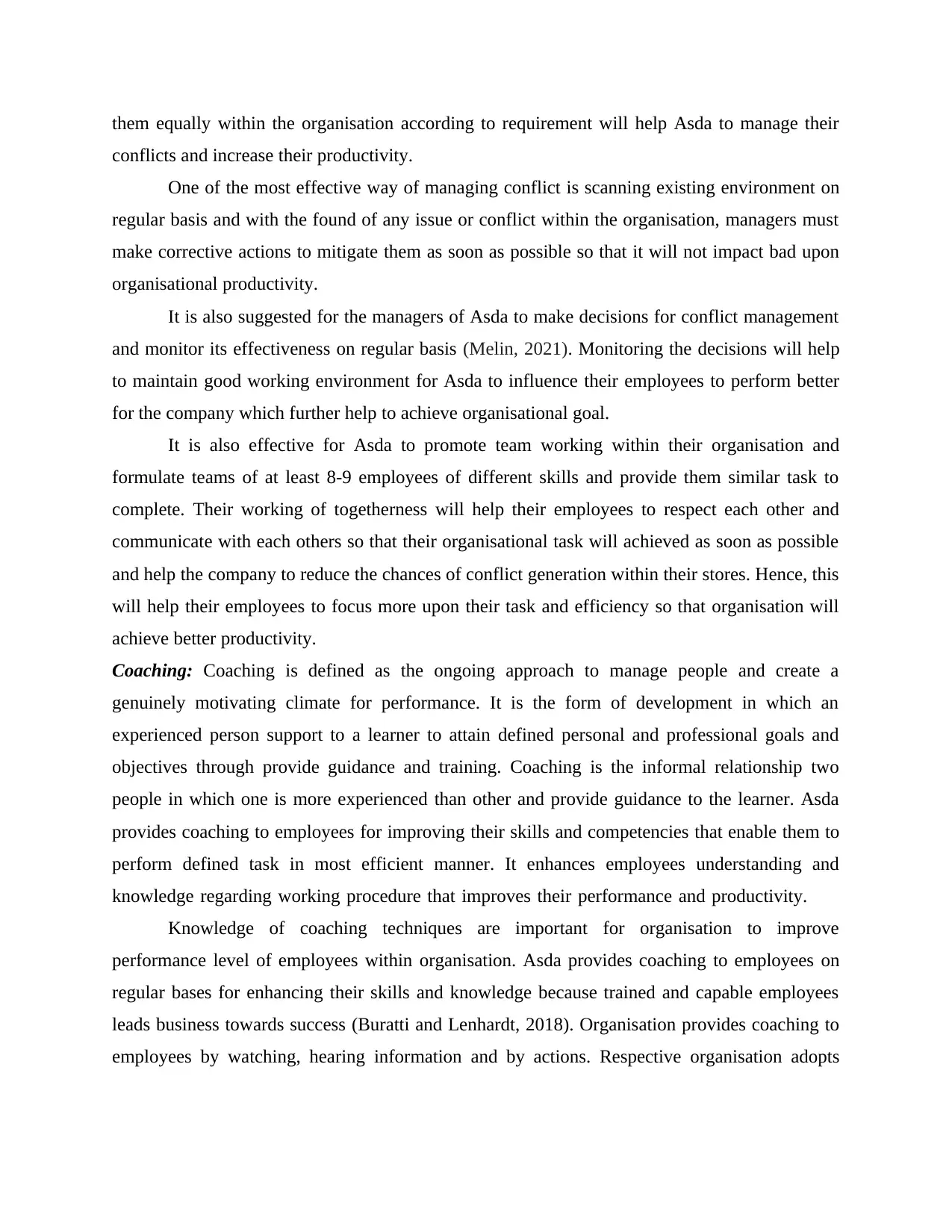
them equally within the organisation according to requirement will help Asda to manage their
conflicts and increase their productivity.
One of the most effective way of managing conflict is scanning existing environment on
regular basis and with the found of any issue or conflict within the organisation, managers must
make corrective actions to mitigate them as soon as possible so that it will not impact bad upon
organisational productivity.
It is also suggested for the managers of Asda to make decisions for conflict management
and monitor its effectiveness on regular basis (Melin, 2021). Monitoring the decisions will help
to maintain good working environment for Asda to influence their employees to perform better
for the company which further help to achieve organisational goal.
It is also effective for Asda to promote team working within their organisation and
formulate teams of at least 8-9 employees of different skills and provide them similar task to
complete. Their working of togetherness will help their employees to respect each other and
communicate with each others so that their organisational task will achieved as soon as possible
and help the company to reduce the chances of conflict generation within their stores. Hence, this
will help their employees to focus more upon their task and efficiency so that organisation will
achieve better productivity.
Coaching: Coaching is defined as the ongoing approach to manage people and create a
genuinely motivating climate for performance. It is the form of development in which an
experienced person support to a learner to attain defined personal and professional goals and
objectives through provide guidance and training. Coaching is the informal relationship two
people in which one is more experienced than other and provide guidance to the learner. Asda
provides coaching to employees for improving their skills and competencies that enable them to
perform defined task in most efficient manner. It enhances employees understanding and
knowledge regarding working procedure that improves their performance and productivity.
Knowledge of coaching techniques are important for organisation to improve
performance level of employees within organisation. Asda provides coaching to employees on
regular bases for enhancing their skills and knowledge because trained and capable employees
leads business towards success (Buratti and Lenhardt, 2018). Organisation provides coaching to
employees by watching, hearing information and by actions. Respective organisation adopts
conflicts and increase their productivity.
One of the most effective way of managing conflict is scanning existing environment on
regular basis and with the found of any issue or conflict within the organisation, managers must
make corrective actions to mitigate them as soon as possible so that it will not impact bad upon
organisational productivity.
It is also suggested for the managers of Asda to make decisions for conflict management
and monitor its effectiveness on regular basis (Melin, 2021). Monitoring the decisions will help
to maintain good working environment for Asda to influence their employees to perform better
for the company which further help to achieve organisational goal.
It is also effective for Asda to promote team working within their organisation and
formulate teams of at least 8-9 employees of different skills and provide them similar task to
complete. Their working of togetherness will help their employees to respect each other and
communicate with each others so that their organisational task will achieved as soon as possible
and help the company to reduce the chances of conflict generation within their stores. Hence, this
will help their employees to focus more upon their task and efficiency so that organisation will
achieve better productivity.
Coaching: Coaching is defined as the ongoing approach to manage people and create a
genuinely motivating climate for performance. It is the form of development in which an
experienced person support to a learner to attain defined personal and professional goals and
objectives through provide guidance and training. Coaching is the informal relationship two
people in which one is more experienced than other and provide guidance to the learner. Asda
provides coaching to employees for improving their skills and competencies that enable them to
perform defined task in most efficient manner. It enhances employees understanding and
knowledge regarding working procedure that improves their performance and productivity.
Knowledge of coaching techniques are important for organisation to improve
performance level of employees within organisation. Asda provides coaching to employees on
regular bases for enhancing their skills and knowledge because trained and capable employees
leads business towards success (Buratti and Lenhardt, 2018). Organisation provides coaching to
employees by watching, hearing information and by actions. Respective organisation adopts
⊘ This is a preview!⊘
Do you want full access?
Subscribe today to unlock all pages.

Trusted by 1+ million students worldwide
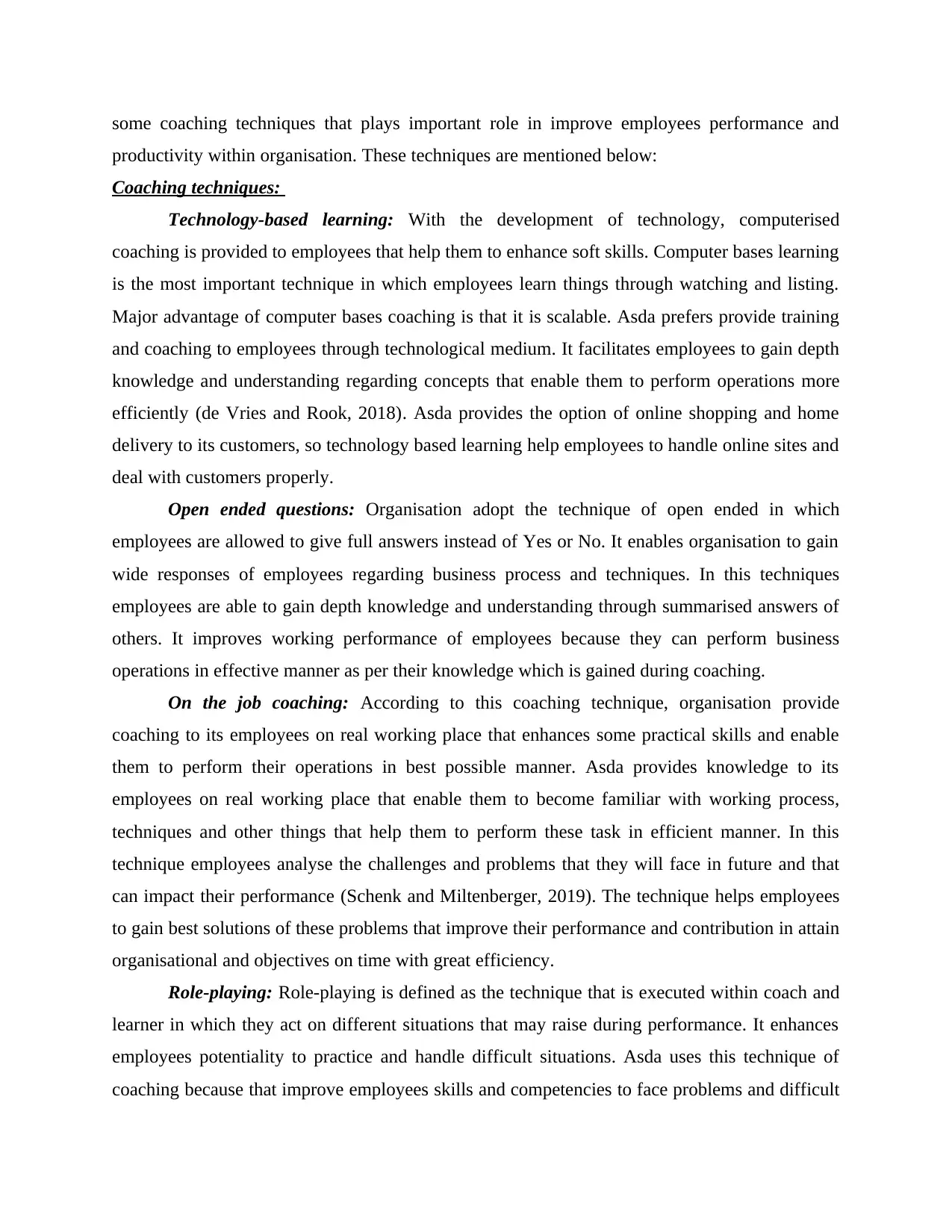
some coaching techniques that plays important role in improve employees performance and
productivity within organisation. These techniques are mentioned below:
Coaching techniques:
Technology-based learning: With the development of technology, computerised
coaching is provided to employees that help them to enhance soft skills. Computer bases learning
is the most important technique in which employees learn things through watching and listing.
Major advantage of computer bases coaching is that it is scalable. Asda prefers provide training
and coaching to employees through technological medium. It facilitates employees to gain depth
knowledge and understanding regarding concepts that enable them to perform operations more
efficiently (de Vries and Rook, 2018). Asda provides the option of online shopping and home
delivery to its customers, so technology based learning help employees to handle online sites and
deal with customers properly.
Open ended questions: Organisation adopt the technique of open ended in which
employees are allowed to give full answers instead of Yes or No. It enables organisation to gain
wide responses of employees regarding business process and techniques. In this techniques
employees are able to gain depth knowledge and understanding through summarised answers of
others. It improves working performance of employees because they can perform business
operations in effective manner as per their knowledge which is gained during coaching.
On the job coaching: According to this coaching technique, organisation provide
coaching to its employees on real working place that enhances some practical skills and enable
them to perform their operations in best possible manner. Asda provides knowledge to its
employees on real working place that enable them to become familiar with working process,
techniques and other things that help them to perform these task in efficient manner. In this
technique employees analyse the challenges and problems that they will face in future and that
can impact their performance (Schenk and Miltenberger, 2019). The technique helps employees
to gain best solutions of these problems that improve their performance and contribution in attain
organisational and objectives on time with great efficiency.
Role-playing: Role-playing is defined as the technique that is executed within coach and
learner in which they act on different situations that may raise during performance. It enhances
employees potentiality to practice and handle difficult situations. Asda uses this technique of
coaching because that improve employees skills and competencies to face problems and difficult
productivity within organisation. These techniques are mentioned below:
Coaching techniques:
Technology-based learning: With the development of technology, computerised
coaching is provided to employees that help them to enhance soft skills. Computer bases learning
is the most important technique in which employees learn things through watching and listing.
Major advantage of computer bases coaching is that it is scalable. Asda prefers provide training
and coaching to employees through technological medium. It facilitates employees to gain depth
knowledge and understanding regarding concepts that enable them to perform operations more
efficiently (de Vries and Rook, 2018). Asda provides the option of online shopping and home
delivery to its customers, so technology based learning help employees to handle online sites and
deal with customers properly.
Open ended questions: Organisation adopt the technique of open ended in which
employees are allowed to give full answers instead of Yes or No. It enables organisation to gain
wide responses of employees regarding business process and techniques. In this techniques
employees are able to gain depth knowledge and understanding through summarised answers of
others. It improves working performance of employees because they can perform business
operations in effective manner as per their knowledge which is gained during coaching.
On the job coaching: According to this coaching technique, organisation provide
coaching to its employees on real working place that enhances some practical skills and enable
them to perform their operations in best possible manner. Asda provides knowledge to its
employees on real working place that enable them to become familiar with working process,
techniques and other things that help them to perform these task in efficient manner. In this
technique employees analyse the challenges and problems that they will face in future and that
can impact their performance (Schenk and Miltenberger, 2019). The technique helps employees
to gain best solutions of these problems that improve their performance and contribution in attain
organisational and objectives on time with great efficiency.
Role-playing: Role-playing is defined as the technique that is executed within coach and
learner in which they act on different situations that may raise during performance. It enhances
employees potentiality to practice and handle difficult situations. Asda uses this technique of
coaching because that improve employees skills and competencies to face problems and difficult
Paraphrase This Document
Need a fresh take? Get an instant paraphrase of this document with our AI Paraphraser

situations that are faced by them in role-playing session. Role-playing facilitates employees to
analyse each and every aspect of situation that enable them to perform their work in efficient
manner and improve their performance. It helps employees to enhance their productivity level
that make them valuable for organisation.
These are the coaching techniques that are adopted by the organisation to provide training
and coaching to employees that enhance their knowledge and understanding regarding their work
role in organisation and how to perform to achieve defined goals and objectives. It enhances
employees working performance and productivity.
Importance of coaching to improve employees working performance:
Improve employees performance: Coaching plays important role in enhancing
employees performance through enhancing their individual skills that enable them to understand
their role in organisation. When employees have understanding about their roles and working
then it enable them to achieve high work performance objectives. Asda provides coaching to
employees through implementing different types of coaching techniques that helps them to
understand each aspect of working procedure and enhance their working performance as well.
Skilled and talented employees also contribute in attaining business goals and objectives on time
with efficient way.
Establish open communication and provide feedback: In coaching open communication
is used that builds trust and make employees comfortable to share their ideas, thoughts and
opinions. It enables employees to understand the concepts clearly and enhance knowledge that
enables to perform business operations properly. Throughout the coaching, regular feedbacks are
provided to employees that provide chance to improve skills. It facilitates employees to perform
their defined task with full efficiency and effectiveness.
Improve employees engagement rate: Coaching is important for enhancing employees
engagement rate with organisation. Asda provides on-going coaching to its employees that
enhance their morale and retain them with organisation for longer period of time. As highly
engages employees retain with organisation and enable them to improve their productivity ratio.
If employees gain regular training in organisation that enhances their skills and competencies
regarding their work (Wolfenden, 2020). It helps them to perform determined task and contribute
in business goals and objectives.
analyse each and every aspect of situation that enable them to perform their work in efficient
manner and improve their performance. It helps employees to enhance their productivity level
that make them valuable for organisation.
These are the coaching techniques that are adopted by the organisation to provide training
and coaching to employees that enhance their knowledge and understanding regarding their work
role in organisation and how to perform to achieve defined goals and objectives. It enhances
employees working performance and productivity.
Importance of coaching to improve employees working performance:
Improve employees performance: Coaching plays important role in enhancing
employees performance through enhancing their individual skills that enable them to understand
their role in organisation. When employees have understanding about their roles and working
then it enable them to achieve high work performance objectives. Asda provides coaching to
employees through implementing different types of coaching techniques that helps them to
understand each aspect of working procedure and enhance their working performance as well.
Skilled and talented employees also contribute in attaining business goals and objectives on time
with efficient way.
Establish open communication and provide feedback: In coaching open communication
is used that builds trust and make employees comfortable to share their ideas, thoughts and
opinions. It enables employees to understand the concepts clearly and enhance knowledge that
enables to perform business operations properly. Throughout the coaching, regular feedbacks are
provided to employees that provide chance to improve skills. It facilitates employees to perform
their defined task with full efficiency and effectiveness.
Improve employees engagement rate: Coaching is important for enhancing employees
engagement rate with organisation. Asda provides on-going coaching to its employees that
enhance their morale and retain them with organisation for longer period of time. As highly
engages employees retain with organisation and enable them to improve their productivity ratio.
If employees gain regular training in organisation that enhances their skills and competencies
regarding their work (Wolfenden, 2020). It helps them to perform determined task and contribute
in business goals and objectives.
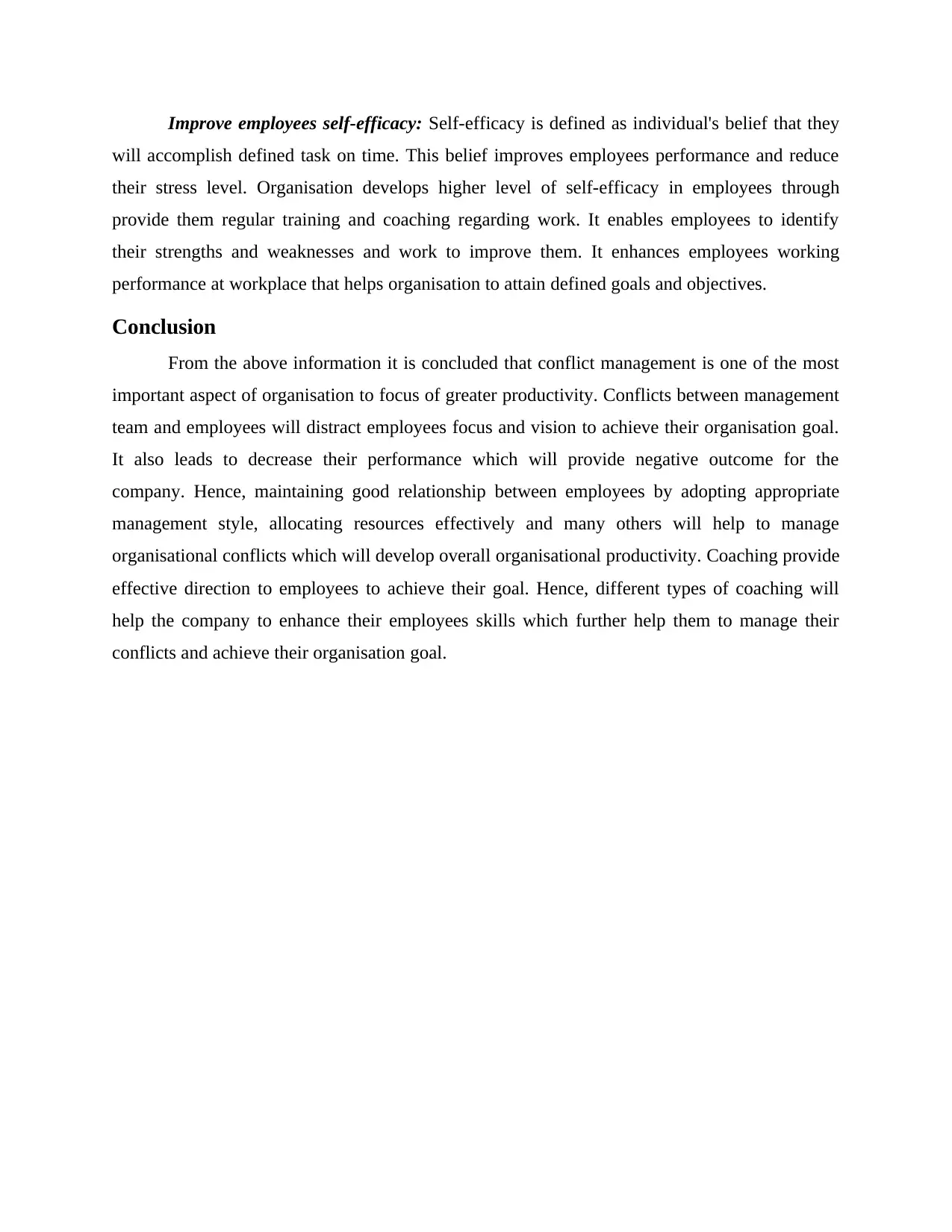
Improve employees self-efficacy: Self-efficacy is defined as individual's belief that they
will accomplish defined task on time. This belief improves employees performance and reduce
their stress level. Organisation develops higher level of self-efficacy in employees through
provide them regular training and coaching regarding work. It enables employees to identify
their strengths and weaknesses and work to improve them. It enhances employees working
performance at workplace that helps organisation to attain defined goals and objectives.
Conclusion
From the above information it is concluded that conflict management is one of the most
important aspect of organisation to focus of greater productivity. Conflicts between management
team and employees will distract employees focus and vision to achieve their organisation goal.
It also leads to decrease their performance which will provide negative outcome for the
company. Hence, maintaining good relationship between employees by adopting appropriate
management style, allocating resources effectively and many others will help to manage
organisational conflicts which will develop overall organisational productivity. Coaching provide
effective direction to employees to achieve their goal. Hence, different types of coaching will
help the company to enhance their employees skills which further help them to manage their
conflicts and achieve their organisation goal.
will accomplish defined task on time. This belief improves employees performance and reduce
their stress level. Organisation develops higher level of self-efficacy in employees through
provide them regular training and coaching regarding work. It enables employees to identify
their strengths and weaknesses and work to improve them. It enhances employees working
performance at workplace that helps organisation to attain defined goals and objectives.
Conclusion
From the above information it is concluded that conflict management is one of the most
important aspect of organisation to focus of greater productivity. Conflicts between management
team and employees will distract employees focus and vision to achieve their organisation goal.
It also leads to decrease their performance which will provide negative outcome for the
company. Hence, maintaining good relationship between employees by adopting appropriate
management style, allocating resources effectively and many others will help to manage
organisational conflicts which will develop overall organisational productivity. Coaching provide
effective direction to employees to achieve their goal. Hence, different types of coaching will
help the company to enhance their employees skills which further help them to manage their
conflicts and achieve their organisation goal.
⊘ This is a preview!⊘
Do you want full access?
Subscribe today to unlock all pages.

Trusted by 1+ million students worldwide
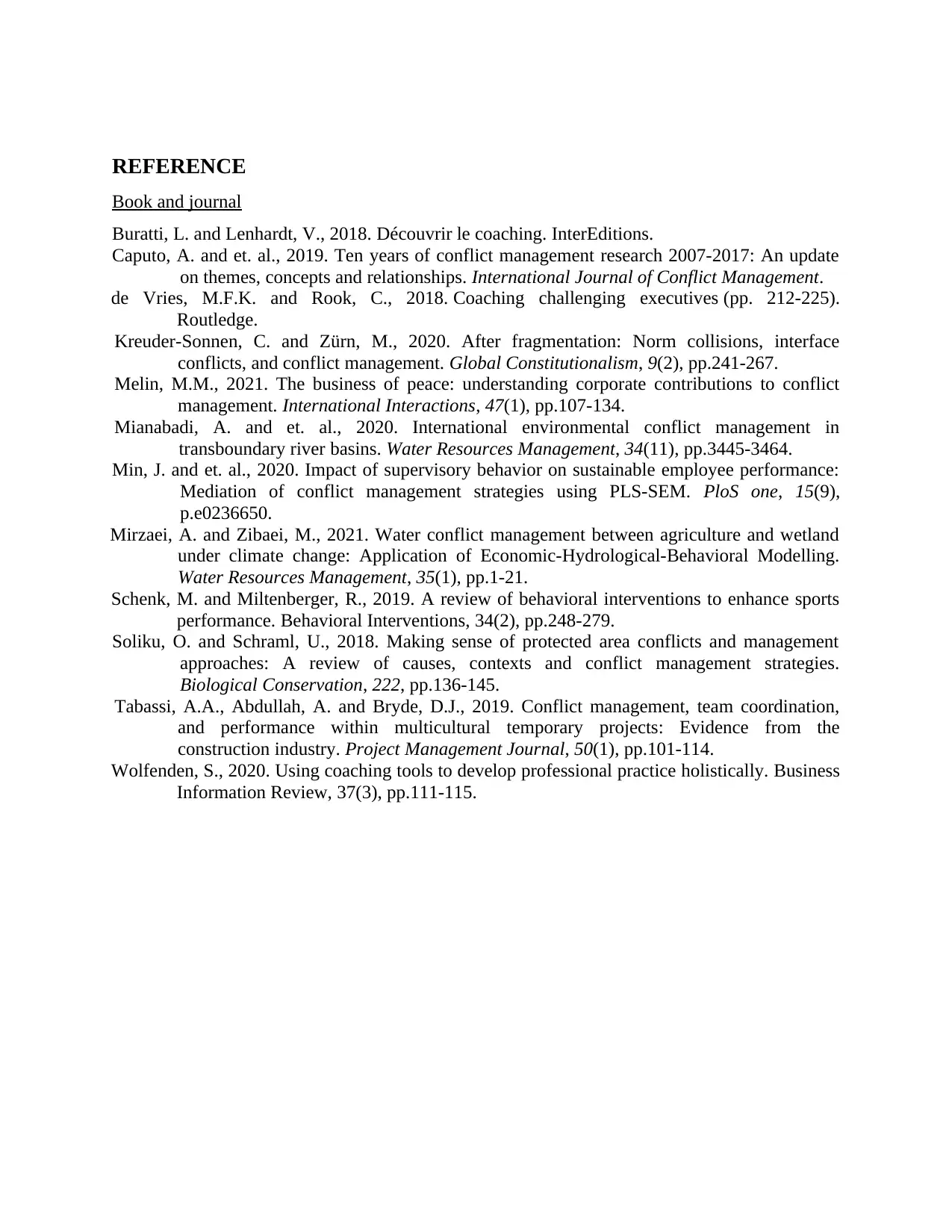
REFERENCE
Book and journal
Buratti, L. and Lenhardt, V., 2018. Découvrir le coaching. InterEditions.
Caputo, A. and et. al., 2019. Ten years of conflict management research 2007-2017: An update
on themes, concepts and relationships. International Journal of Conflict Management.
de Vries, M.F.K. and Rook, C., 2018. Coaching challenging executives (pp. 212-225).
Routledge.
Kreuder-Sonnen, C. and Zürn, M., 2020. After fragmentation: Norm collisions, interface
conflicts, and conflict management. Global Constitutionalism, 9(2), pp.241-267.
Melin, M.M., 2021. The business of peace: understanding corporate contributions to conflict
management. International Interactions, 47(1), pp.107-134.
Mianabadi, A. and et. al., 2020. International environmental conflict management in
transboundary river basins. Water Resources Management, 34(11), pp.3445-3464.
Min, J. and et. al., 2020. Impact of supervisory behavior on sustainable employee performance:
Mediation of conflict management strategies using PLS-SEM. PloS one, 15(9),
p.e0236650.
Mirzaei, A. and Zibaei, M., 2021. Water conflict management between agriculture and wetland
under climate change: Application of Economic-Hydrological-Behavioral Modelling.
Water Resources Management, 35(1), pp.1-21.
Schenk, M. and Miltenberger, R., 2019. A review of behavioral interventions to enhance sports
performance. Behavioral Interventions, 34(2), pp.248-279.
Soliku, O. and Schraml, U., 2018. Making sense of protected area conflicts and management
approaches: A review of causes, contexts and conflict management strategies.
Biological Conservation, 222, pp.136-145.
Tabassi, A.A., Abdullah, A. and Bryde, D.J., 2019. Conflict management, team coordination,
and performance within multicultural temporary projects: Evidence from the
construction industry. Project Management Journal, 50(1), pp.101-114.
Wolfenden, S., 2020. Using coaching tools to develop professional practice holistically. Business
Information Review, 37(3), pp.111-115.
Book and journal
Buratti, L. and Lenhardt, V., 2018. Découvrir le coaching. InterEditions.
Caputo, A. and et. al., 2019. Ten years of conflict management research 2007-2017: An update
on themes, concepts and relationships. International Journal of Conflict Management.
de Vries, M.F.K. and Rook, C., 2018. Coaching challenging executives (pp. 212-225).
Routledge.
Kreuder-Sonnen, C. and Zürn, M., 2020. After fragmentation: Norm collisions, interface
conflicts, and conflict management. Global Constitutionalism, 9(2), pp.241-267.
Melin, M.M., 2021. The business of peace: understanding corporate contributions to conflict
management. International Interactions, 47(1), pp.107-134.
Mianabadi, A. and et. al., 2020. International environmental conflict management in
transboundary river basins. Water Resources Management, 34(11), pp.3445-3464.
Min, J. and et. al., 2020. Impact of supervisory behavior on sustainable employee performance:
Mediation of conflict management strategies using PLS-SEM. PloS one, 15(9),
p.e0236650.
Mirzaei, A. and Zibaei, M., 2021. Water conflict management between agriculture and wetland
under climate change: Application of Economic-Hydrological-Behavioral Modelling.
Water Resources Management, 35(1), pp.1-21.
Schenk, M. and Miltenberger, R., 2019. A review of behavioral interventions to enhance sports
performance. Behavioral Interventions, 34(2), pp.248-279.
Soliku, O. and Schraml, U., 2018. Making sense of protected area conflicts and management
approaches: A review of causes, contexts and conflict management strategies.
Biological Conservation, 222, pp.136-145.
Tabassi, A.A., Abdullah, A. and Bryde, D.J., 2019. Conflict management, team coordination,
and performance within multicultural temporary projects: Evidence from the
construction industry. Project Management Journal, 50(1), pp.101-114.
Wolfenden, S., 2020. Using coaching tools to develop professional practice holistically. Business
Information Review, 37(3), pp.111-115.
1 out of 16
Related Documents
Your All-in-One AI-Powered Toolkit for Academic Success.
+13062052269
info@desklib.com
Available 24*7 on WhatsApp / Email
![[object Object]](/_next/static/media/star-bottom.7253800d.svg)
Unlock your academic potential
© 2024 | Zucol Services PVT LTD | All rights reserved.



